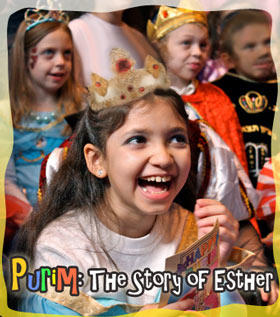Rotation.org Writing Team
Purim: The Story of Esther
Lesson Objectives & Bible Background
 Scripture
Scripture
The Book of Esther
Because the Book of Esther is too long to read in a Sunday School setting, this Rotation lesson set recommends the use of various illustrated Bible storybooks. See recommended titles, including take-home booklets for children in the Esther Resource Page.
Memory Verse: “Who knows? Perhaps you have come to royal dignity for just such a time as this.” Esther 4:14b (NRSV)
Rotation Note: This is a good rotation to begin with "the whole story." In particular, the Video and Computer Workshops do the whole story (or at least, it's major components).
The meaning of Esther's story in a nutshell
Encouraged by her Uncle Mordecai's words, and at the risk of her own life and position, Esther "spoke the truth to power" to save her people.
The Purim Festival, appointed by God celebrates Esther's beautiful faithfulness, and laughs in the face of evil knowing that God is with us, and his victory is sure.
There comes a time and place in every person's life to stand up against evil. And in those times, we trust that God will be with us.
Lesson Objectives for the Rotation
Students will:
- Learn the basic story of Esther.
- Learn what Purim is about, why and how we celebrate it.
- Identify things that need changes or confronted (in the world and within themselves) and ask God for courage and help.
- Remember the verse: “Who knows? Perhaps you have come to royal dignity for just such a time as this.” (Esther 4:14b) as a personal call to do what is right, especially when it means protecting others.
A Note about this Lesson Set's "Tone"
Purim is a joyous festival. The re-telling of Esther's story, the "Esther Sphiel," is often comedic. Many of the lesson activities try to capture this spirit. "Holy Laughter" reminds us that God has won the victory, and that we can stand up and speak out knowing God is with us.
Bible Background for Teachers
Esther's story is a wonderful story for children of all ages as it celebrates "doing the right thing" even when you think you are powerless, trusting that God will be with you.
The "Festival of the Purim" is the key to understanding and presenting the story, and a major part of this set's lessons.
Established as an annual festival by Esther's Uncle Mordecai in Esther 9:26, Jews have been celebrating Esther's story with parties and re-enactments for over 2000 years.
The Purim Festival is where the modern and more secular "Mardi Gras" and "Carnival" celebrations come from. On Purim, Jews are encouraged to wear costumes and masks, re-enact Esther's story, and make fun of evil. It's a party for all ages.
The festival is celebrated on the eve of the Passover season, ...much like Mardi Gras (literally: "Fat" Tuesday) or "Shrove Tuesday" is celebrated on Ash Wednesday, the day before Lent starts. But unlike the modern secular Mardi Gras celebrations, Purim is steeped in the retelling of the Bible story, and its celebrations have a theological meaning: we laugh at evil —knowing God is good. And like Esther, we celebrate our hard-won freedom to worship God.
Laughter and comedy is a big part of Purim, and it is particularly directed at Haman, Esther and the Jewish people's "arch-enemy." Through the story's many twists and turns, Haman gets his come-uppance, and the gallows he had constructed for Mordecai's execution become the place of his own.
Due to its length, character list, and complex plot, you can see why Jews would retell the story every year --to make sure it is remembered! But as Christians, and particular as Sunday School teachers, we don't have the luxury of teaching the entire plot every year. Thus, in this Rotation lesson set, you will do well to teach a BASIC OUTLINE of the story, and stay focused on the outcome: Esther chose to do the right thing, and that saved her people.
Each of the different lessons in this set present the story in a slightly different way and with different emphasis. Over the course of a 4 to 5 week Rotation, your students will learn more detail, and you can add more as their basics build.
The History & Story of Esther in Brief
Chronologically, the story of Esther comes after the story of Daniel and after the return from Babylon to Jerusalem of the first exiled group of Jews in 538 B.C. Originally having been conquered and brought to Babylon in the 7th Century B.C., the majority of Jews chose to stay in Babylon rather than return to their homeland in 538 B.C. —and that group included Mordecai and Esther. Right after the time of Esther, a second and final return of the exiles was led by Ezra (the books of Ezra and Nehemiah), and they brought the story of Esther back to Jerusalem with them.
Why did some Jews stay in Babylon? Because the Persians, led by King Xerxes' father, King Darius, overthrew the Babylonians of Daniel's time, and permitted the Jews to stay and worship as they wanted to. To many, it was where they were born and a safe place. Safe, that is... until Haman came along and tricked Xerxes into signing a law that allowed him to have the Jews killed if they didn't bow down to the King.
Xerxes (Zurk-seez), also known as, "Ahasuerus," (ah-has-sway-roosh), or "Ahashverosh" in Hebrew, was said to be extremely handsome and a great builder. However, he was no prize to live with and he was an extremely cruel king. History tells us that when a storm destroyed a bridge he had commissioned, he had all the bridge builders killed. Yet, God put Esther in his palace to live with him so that her people would be saved.
 The Biblical story and Purim Festival makes a HUGE point of Esther's beauty. And indeed, many young Jewish girls grow up wanting to be her, and looking forward to dressing like her at Purim. But the story also makes a point that her beauty was MORE THAN SKIN DEEP. Her faith put-into-action makes her one of the great super-heroes of the Bible, and is at the root of the modern tradition of dressing up as "super heroes" for Purim. (On the opposite side, Haman is often depicted as ugly or mis-shapen, and Xerxes as a clown.)
The Biblical story and Purim Festival makes a HUGE point of Esther's beauty. And indeed, many young Jewish girls grow up wanting to be her, and looking forward to dressing like her at Purim. But the story also makes a point that her beauty was MORE THAN SKIN DEEP. Her faith put-into-action makes her one of the great super-heroes of the Bible, and is at the root of the modern tradition of dressing up as "super heroes" for Purim. (On the opposite side, Haman is often depicted as ugly or mis-shapen, and Xerxes as a clown.)
Esther was brought to Xerxes' palace to become his new Queen, after his former wife, Queen Vashti, refused to parade her beauty at a party thrown by the King.
The King's second in command was an evil man named Haman. Haman wanted power and position, and was jealous of the King's other advisors, who included among them, a Jew named Mordecai. Unbeknownst to Haman, Queen Esther was related to Mordecai, and she also was a Jew.
When Mordecai refused to bow to anyone but God, to get rid of Mordecai, Haman tricked the King into signing a law that called for the death of those who didn't bow to the king or to his top advisor (Haman). Learning of the law, Mordecai went in secret to Esther to encourage her to speak to the King. At first, she refused, but then he spoke the most famous words of the story, saying, “Who knows? Perhaps you have come to royal dignity for just such a time as this.” Esther 4:14b.
Realizing she had to do something to save her people, Esther throws a party for the King and invites Haman. At that party, she confronts the King and Haman. The King has Haman killed, but says he can't revoke the law. However, he does sign a law allowing the Jews to protect themselves from those who try to oppress them, and make them bow to anyone but God. The Jews thus win a great victory, and Esther's place in history is assured.
Interestingly, the story of Esther is the only book of the Bible which does not mention God. Traditional Jewish interpretation says that this is to teach the people that God is "hidden among us." It is one of the reasons Jews wear costumes and masks to celebrate Purim. Mordecai strongly alludes to God when he tells Esther that she has been "put here."
Your Bible may use the name "Xerxes" or "Ahaseurus." We suggest you use "Xerxes" because it is the common Greek spelling of this historic person, and your students will see it spelled that way in school books. See more notes below about his name.
Xerxes' Kingdom of Susa is located just inside modern day Iran, on the Iraq border, some miles away from the ancient ruins of Babylon in southeastern Iraq.
In Jewish tradition, Esther's story is celebrated as a story of religious freedom and identity. In Christian tradition, it tends to be celebrated as a story about "standing up for your faith."
More About Purim
- The main event of Purim is reading the "Megillah," or "scroll" in synagogues and on street corners.
- In the Persian language, Esther means "star," (Ish-star) but apparently also is from the same Hebrew root word as the term "hester," which can mean "hidden." Such word play is common in Hebrew and meanings.
- The Hebrew word "Pur" means "lots," and is a reference to Haman "casting lots" to determine from his gods the best day to attack the Jews. The lots were like dice.
- Whenever the name of Haman is mentioned in the Megillah, it is tradition that everyone boos, hisses, stamps their feet or rattles "groggers" (noisemakers). The purpose is to "blot out the name of Haman."
- Being "irreverent" during Purim and re-enactments is not only accepted, it is encouraged.
- The Hamentaschen Cookie is a popular treat at Purim. Shaped like a three cornered Haman hat, eating it represents the "devouring of evil by good."
- Interesting note for people who have done a David rotation —Haman was a descendant of Agag, the king who Samuel beheaded because Saul hadn't eliminated him, and all his people, as God instructed. This was the incident that finished Saul as God's chosen king and led to David's anointing.
Making Musical Parodies of the Esther story is a popular tradition. See our Esther Additional Resources Page for links to some cool videos.
For more information, stories, recipes and traditions, search the internet for the word "Purim."
Teachable Moments and Additional Thoughts
As you teach the story over several week and through several different approaches, you can add to your student's understanding. Here are some important ideas you could share.
ADVICE
Esther listens to good advice - Esther 2:20, 2:15, 4:14
Even King Xerxes listens to advice and opinions, though maybe he doesn't consider the source very well! Esther 1:13 ...
The good stuff –advice– comes from people who care about you. Bad advice comes from people who care about themselves.
Contrast Mordecai's (2:19-20) and Hegai's (2:15) advice to Esther with Haman's (3:9 and 6:6-9) and Memucan's (1:17) advice to King Xerxes.
ASKING FOR HELP
It's okay to ask for help when things are tough! Esther asks everyone she can to fast since prayer is an integral part of Jewish fasting. Esther 4:18.
BAD THINGS
They happen, even to people God is preparing to do great things. Esther 2:7 - Esther's parents died.
BEAUTY
It's more than skin-deep. David too was said to be handsome, but like him, Esther's heart was what made her a true super-hero.
CHOICE
Is it God's providential care or coincidence? There are plenty of opportunities to ask kids questions aimed at getting them thinking about the choice we have to see or to ignore God's presence!
CULTURAL AWARENESS
Women in this story did not enjoy the same freedoms we do today. Esther did not choose to go into a harem or to be a queen. Key verse Esther 2:8 - "As a result of the king's decree, Esther, along with many other young women, was brought to the harem at the fortress in Susa and placed in Hegai's care." (NLT) Brought and placed are verbs that indicate that she did not have a choice!
And of course there was the decision to banish Vashti in Esther 1:17-30. Women had no personal power in that place and time and that's still true in some parts of the world.
DISCRETION
Discretion has its place. Esther didn't just blurt out her request.
FINDING THE COURAGE TO STAND UP FOR WHAT IS RIGHT
"Courage is Fear that's said its prayers," and that's one way to sum up Esther 4:8-16. Jewish fasting includes prayer.
INNER BEAUTY
Otherwise known as character counts! Hegai, the head eunuch, liked Esther, lost no time in beginning the beauty treatment and advised her on what to wear when she went to the King. Esther 3:9 and 3:15.
LOYALTY & BEING SUBJECT TO AUTHORITY
This theme is evident throughout the book. Mordecai shows these traits in Esther 2:21 and 4:17. Also, in 3:2 he disobeys Haman —the explanation? "I am a Jew." Unspoken, but implicit in that statement —I worship God alone. This stand illustrates that Mordecai's first allegiance was to a higher authority than Haman.
POWER VERSES AUTHORITY
Haman's goal is personal power. Mordecai and Esther take on the responsibility of leadership. Esther 10:3 describes Mordecai as "one who sought for the good of his people and one who spoke for the welfare of his whole nation."
PRAYER
Isn't prayer an integral aspect of Jewish fasting? Wouldn't that mean that even though the term is fast —Esther asks others to join her as she seeks God's guidance?
PROVIDENTIAL CARE OR COINCIDENCE
How we see this story is ultimately a matter of personal choice.
Esther 6:1 - Why did the king read the right record at just the right time? A related verse would be Deuteronomy 30:19-20 — "So choose life in order that you may live, you and your descendants, by loving the Lord your God, by obeying His voice, and by holding fast to him."
RACISM AND PREJUDICE
Haman plans to kill all Jews because he's mad at one, Esther 3:6. Haman presents his plan by first separating a group of people from all other humans. Esther 3:8 - "They observe customs that are not like those of any other people."
WAITING ON THE LORD
Esther 4:14 - "For such a time as this." God prepares people to do His work in His time. A term for this is "waiting on the Lord." Just as a waiter or waitress in a restaurant is prepared and ready to serve a meal, we can work at being ready and willing to serve the Lord.
Esther didn't live her life intent on someday saving her people. On the other hand, she didn't sit on the sidelines praying and waiting until God told her what to do. She "just" lived her life the best way she could until that pivotal moment —"for just such a time as this ...". She proved herself prepared and ready to serve.
See Isaiah 41:31 for a classic "waiting on the Lord" verse.
Esther and Purim Vocabulary
ESTHER
In Persiah, the name "Esther" is pronounced "Ish-star" and means "Star" in Persian. Ish-star was also the name for the "morning star" known to us as the planet Venus. Her name in Hebrew is "Haddasah" which means, "myrtle" ...a fragrant flower. "Esther" is also close to the word "Hester" which means, "hidden."
PURIM SPHIEL
Sphiel is the Yiddish word for "story" ...usually used to refer to a humorous story or retelling. Retelling the story of Esther in humorous fashion has a long history is Judaism.
The word describing Vashti in Esther 1:11 means beautiful. Esther is also described as beautiful, but the Hebrew words are not the same.
PUR OR PURIM
Pebbles, sticks, or pottery shards that were thrown to make decisions. Haman cast the purim to determine the day the Jews would be exterminated. Proverbs 16:1 - "We may make our plans, but God has the last word."
King Xerxes, aka Ahaseurus, aka Ahashverosh
The name of the king whom Esther marries is spelled and pronounced many different ways depending on your source material and Bible translation."Xerxes" is the common Greek spelling and pronunciation ("Zirq-zees"), and the one most history books use.In Judaism and Hebrew, Xerxes' name is recorded and pronounced as "Ah-hash-ver-row-sh."
"Ahaseurus" is the Latin (Roman Catholic) spelling and pronunciation. ("A-ha-sway-roosh").
Also known as, "Xerxes the Great," Xerxes is the one who invaded Greece and fought the famed Battle of Thermopylae against the 300 warriors (immortalized and caricatured in the popular Hollywood movie, "The 300").His father Darius I, is the king during the time of Daniel. Darius is the one who overthrew the Babylonians (King Nebuchadnezzar), and stopped the persecution of the Jews —which we read about in Daniel. This is why Haman's plot is particularly dastardly. He sought a return to the persecution of the Jews which Xerxes' father had ended.
Xerxes' third son "Artaxerxes" ascended the throne after Xerxes was murdered by the leader of his palace guard. It was Artaxerxes who gave permission to Ezra and Nehemiah to return to Jerusalem and rebuild it.
The Period of Time:
Darius I: c. 550–486 BC (Time of Daniel)
Xerxes the Great: 486–465 BC (Time of Esther)
Artaxerxes: 465-424 BC (Time of Ezra and Nehemiah)
Written by the Rotation.org Writing Team
with contributions from Sally Priebe, Virginia Colvig, Neil MacQueen, and Anne Camp
Copyright 2016, Rotation.org Inc.
Photo credits:
Girl as Esther courtesy of The Sheep's Head Bay News.
Esther drawing from design42.




